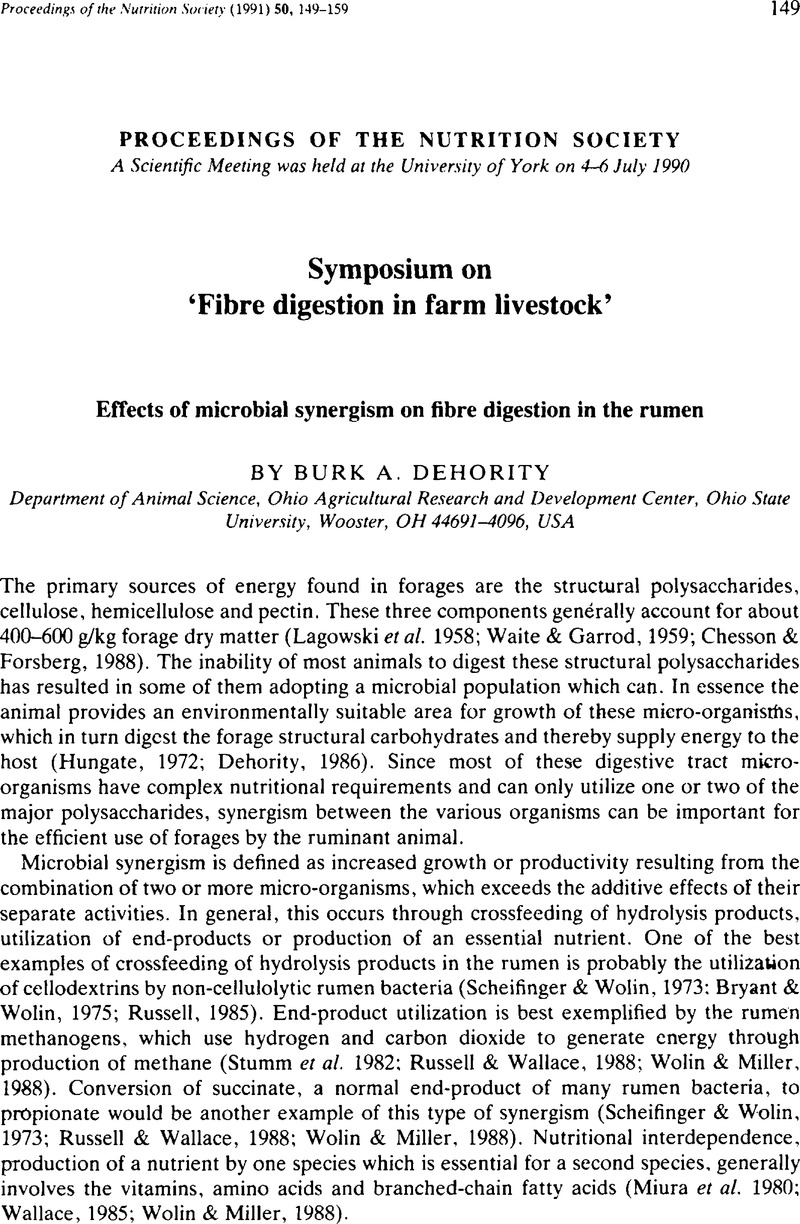Crossref Citations
This article has been cited by the following publications. This list is generated based on data provided by Crossref.
Malburg, L.M.
Smith, D.C.
Schellhorn, H.E.
and
Forsberg, C.W.
1993.
Fibrobacter succinogenes S85 has multiple xylanase genes.
Journal of Applied Bacteriology,
Vol. 75,
Issue. 6,
p.
564.
Miron, J.
and
Ben-Ghedalia, D.
1993.
Digestion of structural polysaccharides of Panicum and vetch hays by the rumen bacterial strains Fibrobacter succinogenes BL2 and Butyrivibrio fibrisolvens D1.
Applied Microbiology and Biotechnology,
Vol. 39,
Issue. 6,
p.
756.
Gasparic, A
Martin, J
Daniel, A S
and
Flint, H J
1995.
A xylan hydrolase gene cluster in Prevotella ruminicola B(1)4: sequence relationships, synergistic interactions, and oxygen sensitivity of a novel enzyme with exoxylanase and beta-(1,4)-xylosidase activities.
Applied and Environmental Microbiology,
Vol. 61,
Issue. 8,
p.
2958.
Grathwol, J.
and
Reichl, J.R.
1995.
Simulation of nutrient dynamics in the rumen of sheep and cattle considering the feed composition, level of feed intake and feeding frequency.
Archiv für Tierernaehrung,
Vol. 47,
Issue. 3,
p.
271.
Luheshi, G.
Miller, A. J.
Brouwer, S.
Dascombe, M. J.
Rothwell, N. J.
and
Hopkins, S. J.
1996.
Interleukin-1 receptor antagonist inhibits endotoxin fever and systemic interleukin-6 induction in the rat.
American Journal of Physiology-Endocrinology and Metabolism,
Vol. 270,
Issue. 1,
p.
E91.
Flint, Harry J
Whitehead, Terence R
Martin, Jennifer C
and
Gasparic, Ales
1997.
Interrupted catalytic domain structures in xylanases from two distantly related strains of Prevotella ruminicola.
Biochimica et Biophysica Acta (BBA) - Protein Structure and Molecular Enzymology,
Vol. 1337,
Issue. 2,
p.
161.
Dolfing, Jan
and
Gottschal, Jan C.
1997.
Gastrointestinal Microbiology.
p.
373.
Miyazaki, K
Martin, J.C
Marinsek-Logar, R
and
Flint, H.J
1997.
Degradation and Utilization of Xylans by the Rumen AnaerobePrevotella bryantii(formerlyP. ruminicolasubsp.brevis) B14.
Anaerobe,
Vol. 3,
Issue. 6,
p.
373.
Stewart, C. S.
Flint, H. J.
and
Bryant, M. P.
1997.
The Rumen Microbial Ecosystem.
p.
10.
Annison, E. F.
and
Bryden, W. L.
1998.
Perspectives on ruminant nutrition and metabolism I. Metabolism in the Rumen.
Nutrition Research Reviews,
Vol. 11,
Issue. 2,
p.
173.
Ye, X.Y.
Ng, T.B.
and
Cheng, K.J.
2001.
Purification and characterization of a cellulase from the ruminal fungus Orpinomyces joyonii cloned in Escherichia coli.
The International Journal of Biochemistry & Cell Biology,
Vol. 33,
Issue. 1,
p.
87.
Kocherginskaya, Svetlana A.
Aminov, Rustam I.
and
White, Bryan A.
2001.
Analysis of the Rumen Bacterial Diversity under two Different Diet Conditions using Denaturing Gradient Gel Electrophoresis, Random Sequencing, and Statistical Ecology Approaches.
Anaerobe,
Vol. 7,
Issue. 3,
p.
119.
Witten, G.Q.
and
Richardson, F.D.
2003.
Competition of three aggregated microbial species for four substrates in the rumen.
Ecological Modelling,
Vol. 164,
Issue. 2-3,
p.
121.
Noftsger, S.M.
St-Pierre, N.R.
Karnati, S.K.R.
and
Firkins, J.L.
2003.
Effects of 2-Hydroxy-4-(methylthio) Butanoic Acid (HMB) on Microbial Growth in Continuous Culture.
Journal of Dairy Science,
Vol. 86,
Issue. 8,
p.
2629.
Miyazaki, Kohji
Miyamoto, Hiroyuki
Mercer, Derry K.
Hirase, Tatsuaki
Martin, Jennifer C.
Kojima, Yoichi
and
Flint, Harry J.
2003.
Involvement of the Multidomain Regulatory Protein XynR in Positive Control of Xylanase Gene Expression in the Ruminal Anaerobe
Prevotella bryantii
B
1
4
.
Journal of Bacteriology,
Vol. 185,
Issue. 7,
p.
2219.
Ng, T.B
2004.
Peptides and proteins from fungi.
Peptides,
Vol. 25,
Issue. 6,
p.
1055.
Flint, Harry J.
2004.
Vol. 56,
Issue. ,
p.
89.
Belenguer, Alvaro
Duncan, Sylvia H.
Calder, A. Graham
Holtrop, Grietje
Louis, Petra
Lobley, Gerald E.
and
Flint, Harry J.
2006.
Two Routes of Metabolic Cross-Feeding betweenBifidobacterium adolescentisand Butyrate-Producing Anaerobes from the Human Gut.
Applied and Environmental Microbiology,
Vol. 72,
Issue. 5,
p.
3593.
Flint, Harry J.
Duncan, Sylvia H.
Scott, Karen P.
and
Louis, Petra
2007.
Interactions and competition within the microbial community of the human colon: links between diet and health.
Environmental Microbiology,
Vol. 9,
Issue. 5,
p.
1101.
Walker, Alan W.
Duncan, Sylvia H.
Harmsen, Hermie J. M.
Holtrop, Grietje
Welling, Gjalt W.
and
Flint, Harry J.
2008.
The species composition of the human intestinal microbiota differs between particle‐associated and liquid phase communities.
Environmental Microbiology,
Vol. 10,
Issue. 12,
p.
3275.



